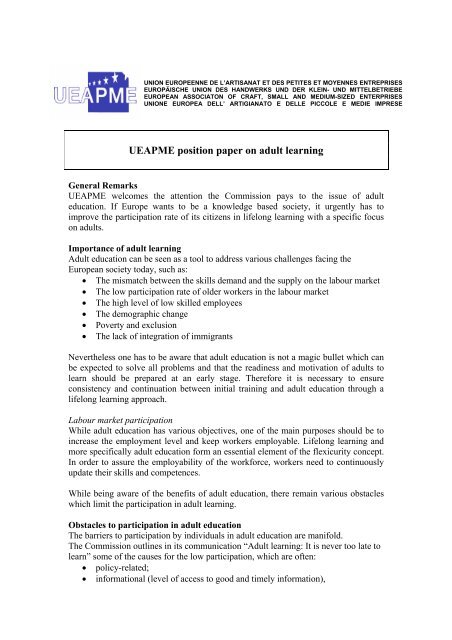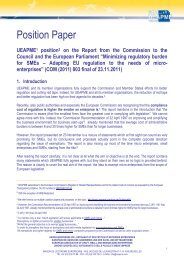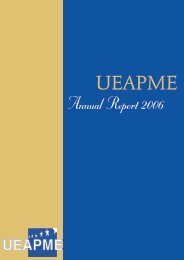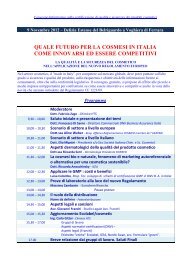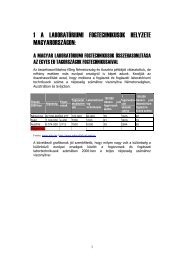UEAPME position paper on adult learning
UEAPME position paper on adult learning
UEAPME position paper on adult learning
Create successful ePaper yourself
Turn your PDF publications into a flip-book with our unique Google optimized e-Paper software.
UNION EUROPEENNE DE L’ARTISANAT ET DES PETITES ET MOYENNES ENTREPRISES<br />
EUROPÄISCHE UNION DES HANDWERKS UND DER KLEIN- UND MITTELBETRIEBE<br />
EUROPEAN ASSOCIATON OF CRAFT, SMALL AND MEDIUM-SIZED ENTERPRISES<br />
UNIONE EUROPEA DELL’ ARTIGIANATO E DELLE PICCOLE E MEDIE IMPRESE<br />
<str<strong>on</strong>g>UEAPME</str<strong>on</strong>g> <str<strong>on</strong>g>positi<strong>on</strong></str<strong>on</strong>g> <str<strong>on</strong>g>paper</str<strong>on</strong>g> <strong>on</strong> <strong>adult</strong> <strong>learning</strong><br />
General Remarks<br />
<str<strong>on</strong>g>UEAPME</str<strong>on</strong>g> welcomes the attenti<strong>on</strong> the Commissi<strong>on</strong> pays to the issue of <strong>adult</strong><br />
educati<strong>on</strong>. If Europe wants to be a knowledge based society, it urgently has to<br />
improve the participati<strong>on</strong> rate of its citizens in lifel<strong>on</strong>g <strong>learning</strong> with a specific focus<br />
<strong>on</strong> <strong>adult</strong>s.<br />
Importance of <strong>adult</strong> <strong>learning</strong><br />
Adult educati<strong>on</strong> can be seen as a tool to address various challenges facing the<br />
European society today, such as:<br />
• The mismatch between the skills demand and the supply <strong>on</strong> the labour market<br />
• The low participati<strong>on</strong> rate of older workers in the labour market<br />
• The high level of low skilled employees<br />
• The demographic change<br />
• Poverty and exclusi<strong>on</strong><br />
• The lack of integrati<strong>on</strong> of immigrants<br />
Nevertheless <strong>on</strong>e has to be aware that <strong>adult</strong> educati<strong>on</strong> is not a magic bullet which can<br />
be expected to solve all problems and that the readiness and motivati<strong>on</strong> of <strong>adult</strong>s to<br />
learn should be prepared at an early stage. Therefore it is necessary to ensure<br />
c<strong>on</strong>sistency and c<strong>on</strong>tinuati<strong>on</strong> between initial training and <strong>adult</strong> educati<strong>on</strong> through a<br />
lifel<strong>on</strong>g <strong>learning</strong> approach.<br />
Labour market participati<strong>on</strong><br />
While <strong>adult</strong> educati<strong>on</strong> has various objectives, <strong>on</strong>e of the main purposes should be to<br />
increase the employment level and keep workers employable. Lifel<strong>on</strong>g <strong>learning</strong> and<br />
more specifically <strong>adult</strong> educati<strong>on</strong> form an essential element of the flexicurity c<strong>on</strong>cept.<br />
In order to assure the employability of the workforce, workers need to c<strong>on</strong>tinuously<br />
update their skills and competences.<br />
While being aware of the benefits of <strong>adult</strong> educati<strong>on</strong>, there remain various obstacles<br />
which limit the participati<strong>on</strong> in <strong>adult</strong> <strong>learning</strong>.<br />
Obstacles to participati<strong>on</strong> in <strong>adult</strong> educati<strong>on</strong><br />
The barriers to participati<strong>on</strong> by individuals in <strong>adult</strong> educati<strong>on</strong> are manifold.<br />
The Commissi<strong>on</strong> outlines in its communicati<strong>on</strong> “Adult <strong>learning</strong>: It is never too late to<br />
learn” some of the causes for the low participati<strong>on</strong>, which are often:<br />
• policy-related;<br />
• informati<strong>on</strong>al (level of access to good and timely informati<strong>on</strong>),
• provider-related (entry requirements, cost, level of <strong>learning</strong> support, , nature of<br />
<strong>learning</strong> outcomes, etc);<br />
• situati<strong>on</strong>al (the cultural value attached to educati<strong>on</strong>; the extent to which the<br />
life situati<strong>on</strong> or the family and social envir<strong>on</strong>ment of the <strong>adult</strong> supports<br />
participati<strong>on</strong>)<br />
• dis<str<strong>on</strong>g>positi<strong>on</strong></str<strong>on</strong>g>al (the self-esteem and self-c<strong>on</strong>fidence of the <strong>adult</strong> as a learner,<br />
often linked to failure in previous educati<strong>on</strong>al experiences).<br />
<str<strong>on</strong>g>UEAPME</str<strong>on</strong>g> agrees with the Commissi<strong>on</strong> that demand-side reas<strong>on</strong>s are often the most<br />
serious barriers: lack of time, due to work or family reas<strong>on</strong>s; lack of awareness and<br />
motivati<strong>on</strong>, as people do not see <strong>learning</strong> valued or rewarded enough and hence fail<br />
to perceive its benefits; lack of informati<strong>on</strong> <strong>on</strong> the supply and lack of financing. 1<br />
Motivati<strong>on</strong> is the key denominator. As there are different reas<strong>on</strong>s for participating in<br />
<strong>adult</strong> educati<strong>on</strong> (such as for professi<strong>on</strong>al reas<strong>on</strong>s, for societal and for pers<strong>on</strong>al<br />
development), the level of motivati<strong>on</strong> varies significantly according to the purpose of<br />
participating in <strong>adult</strong> educati<strong>on</strong>.<br />
Unfortunately, there is a significant segregati<strong>on</strong> in the uptake of lifel<strong>on</strong>g <strong>learning</strong>.<br />
Mainly higher educated people participate in c<strong>on</strong>tinuous educati<strong>on</strong>, while the<br />
participati<strong>on</strong> rate of lower educated people is poorer. There is a need for creating a<br />
str<strong>on</strong>g European <strong>learning</strong> culture.<br />
Addressing these obstacles<br />
Improving awareness and guidance<br />
In order to achieve a European <strong>learning</strong> culture and increase the participati<strong>on</strong> in<br />
lifel<strong>on</strong>g <strong>learning</strong>, it is crucial that the benefits of lifel<strong>on</strong>g <strong>learning</strong> are made clear to<br />
the individual workers and companies in particular by using the <strong>learning</strong> outcomes<br />
approach. This requires better and more accessible informati<strong>on</strong> and communicati<strong>on</strong><br />
<strong>on</strong> the added value of c<strong>on</strong>tinuous <strong>learning</strong>.<br />
Moreover individuals and small organisati<strong>on</strong>s have a real need for guidance. They<br />
should be better informed <strong>on</strong> the existence and availability of training possibilities,<br />
but also better accompanied in their choices and the possible use in their daily life.<br />
Intermediate bodies such as craft chambers are key since they are locally organised,<br />
have direct c<strong>on</strong>tacts with the businesses and are present all over the country.<br />
Furthermore, it is often forgotten that craft and small entrepreneurs also need<br />
c<strong>on</strong>tinuous training, in order to stay competitive. However, the difficulties they face<br />
for participating in <strong>adult</strong> educati<strong>on</strong>, such as a very limited time schedule and lack of<br />
focused informati<strong>on</strong> <strong>on</strong> training offers, are not adequately addressed.<br />
New educati<strong>on</strong>al methods<br />
An important challenge in the field of <strong>adult</strong> educati<strong>on</strong> is the need to adapt the classical<br />
pedagogical methods to the specific needs of a populati<strong>on</strong> which has other demands<br />
than sec<strong>on</strong>dary pupils or students.<br />
1 Communicati<strong>on</strong> from the Commissi<strong>on</strong> Adult <strong>learning</strong>: It is never too late to learn
Adults, who are willing to learn, are more keen to make use of <strong>on</strong> the job acquired<br />
experience.<br />
In most cases the current offer does not corresp<strong>on</strong>d to the high expectati<strong>on</strong>s of these<br />
groups of populati<strong>on</strong>.<br />
Real efforts should be made to better adapt the training offer to a mature audience and<br />
to propose new pedagogical approaches and methods using new technologies and the<br />
knowledge of individuals.<br />
Role of intermediary bodies in tailored made training offers for craft and small<br />
companies<br />
Part of <strong>adult</strong> educati<strong>on</strong> c<strong>on</strong>cerns entrepreneurs and workers. In this case, the training<br />
offer is rarely adapted to the training needs of craft and small businesses. In a small<br />
company, training needs differ between the various employees and should be tailored<br />
made according to the needs of each individual.<br />
In this respect, it is important to highlight the role of intermediary bodies as training<br />
providers such as professi<strong>on</strong>al organisati<strong>on</strong>s, craft chambers or other types of<br />
instituti<strong>on</strong>s, which can better resp<strong>on</strong>d to the training needs, as they are closely linked<br />
to the local level, and are aware of the required skills for companies and the labour<br />
market.<br />
Intergenerati<strong>on</strong>al approach<br />
Furthermore, while looking at <strong>adult</strong> educati<strong>on</strong>, <strong>on</strong>e should not forget the link to initial<br />
educati<strong>on</strong> and training. If people do not receive adequate and relevant educati<strong>on</strong> and<br />
training before they enter the labour market, taking up <strong>adult</strong> <strong>learning</strong> will become less<br />
obvious and more difficult. Therefore increasing the attractiveness of initial VET and<br />
its uptake facilitate a higher participati<strong>on</strong> in <strong>adult</strong> <strong>learning</strong>.<br />
Role of the European level<br />
The European Uni<strong>on</strong> sets itself the goal to have by “2010 the European Uni<strong>on</strong> average<br />
level of participati<strong>on</strong> in lifel<strong>on</strong>g <strong>learning</strong> should at least be 12.5% of the <strong>adult</strong><br />
working-age populati<strong>on</strong> (age 25-64)”. Currently, there are huge differences between<br />
the Member States with variati<strong>on</strong> from the EU average ranging from 1.1% to 34.7%. 2<br />
<str<strong>on</strong>g>UEAPME</str<strong>on</strong>g> underlines the fact that acti<strong>on</strong>s need to be taken at nati<strong>on</strong>al level.<br />
Nevertheless, in a situati<strong>on</strong> of such extreme variati<strong>on</strong>s, the use of peer review and<br />
exchange of good practises are suitable tools to address this issue at European level.<br />
Facilitate investment in c<strong>on</strong>tinuous training for <strong>adult</strong>s<br />
European Social partners have c<strong>on</strong>cluded in 2002 a Framework of Acti<strong>on</strong>s <strong>on</strong> the<br />
Lifel<strong>on</strong>g Development of Competencies and Qualificati<strong>on</strong>s. 3 As part of this they<br />
outlined the principle of shared resp<strong>on</strong>sibility between the different actors.<br />
They also identified the need to ensure that the taxati<strong>on</strong> of enterprises and individuals<br />
encourages investment in competencies development activities. The support from<br />
public authorities is crucial. SMEs in particular need support during the periods when<br />
some of their workers are absent in order to receive training.<br />
2 Progress towards the Lisb<strong>on</strong> objectives in educati<strong>on</strong> and training – Report based <strong>on</strong> indicators and benchmarks – Report 2006,<br />
pages 35-40, and its Annex “Detailed analysis of progress”, chapter 6.2.<br />
3http://www.ueapme.com/docs/pos_<str<strong>on</strong>g>paper</str<strong>on</strong>g>s/2002/FINAL%20DSE%20Framework%20of%20acti<strong>on</strong>s%20EN.doc
Adult educati<strong>on</strong> should not be of the sole resp<strong>on</strong>sibility of employers. Each citizen<br />
has a role to play in his or her pers<strong>on</strong>al development. Public authorities are also key<br />
actors for an important part of the <strong>adult</strong> populati<strong>on</strong> not directly involved in the<br />
ec<strong>on</strong>omy such as the inactive populati<strong>on</strong>, unemployed people, early retired workers,<br />
young people without qualificati<strong>on</strong>s, etc…<br />
C<strong>on</strong>cerning investment in <strong>adult</strong> educati<strong>on</strong>, <str<strong>on</strong>g>UEAPME</str<strong>on</strong>g> firmly believes in publicprivate<br />
partnership. Co-financing should be the guiding principle <strong>on</strong> this issue, where<br />
public funding could serve as a lever to attract private funds. This could be either by<br />
providing fiscal incentives for companies to invest into <strong>adult</strong> educati<strong>on</strong> or by creating<br />
individual <strong>learning</strong> accounts, which are supported financially by the public authority<br />
depending <strong>on</strong> the commitment of the individual.<br />
As the need for c<strong>on</strong>tinuous <strong>learning</strong> for <strong>adult</strong>s will dramatically increase, public<br />
authorities should rethink their priorities in an overall lifel<strong>on</strong>g <strong>learning</strong> perspective<br />
and shift the investment from other educati<strong>on</strong> and training areas towards <strong>adult</strong><br />
<strong>learning</strong>, Since the relative importance of <strong>adult</strong> educati<strong>on</strong> will become more<br />
significant, it should also be accompanied by more efficiency.<br />
Therefore, wherever public financing is used, transparency and efficiency should be<br />
the guiding principles. This is more likely to be successfully achieved in the case<br />
where educati<strong>on</strong> and training providers offer quality assurance.<br />
The European level will play a decisive supportive role though its Lifel<strong>on</strong>g Leaning<br />
programme and by making the new European Social Fund available for the use of<br />
<strong>adult</strong> educati<strong>on</strong>. However, it is not <strong>on</strong>ly a questi<strong>on</strong> of quantity of investment but a<br />
questi<strong>on</strong> of quality of investment in educati<strong>on</strong> and training. Making nati<strong>on</strong>al systems<br />
more cost/effective should be the main leitmotiv for all.<br />
C<strong>on</strong>clusi<strong>on</strong><br />
• Adult educati<strong>on</strong> is an important tool in addressing some of the challenges<br />
facing the European society, such as low employment levels, the demographic<br />
change, poverty and exclusi<strong>on</strong><br />
• One of the biggest obstacles to participati<strong>on</strong> in <strong>adult</strong> educati<strong>on</strong> is the lack of<br />
motivati<strong>on</strong><br />
• One can clearly identify a segregati<strong>on</strong> between higher educated and less<br />
educated citizens in the uptake of <strong>adult</strong> educati<strong>on</strong> which needs to be addressed<br />
• Therefore providing informati<strong>on</strong> and guidance are important to enhance<br />
participati<strong>on</strong> in c<strong>on</strong>tinuous educati<strong>on</strong> and for Craft and SMEs intermediary<br />
bodies and professi<strong>on</strong>al organisati<strong>on</strong>s have a key role to play<br />
• There is a need for creating a European <strong>learning</strong> culture<br />
• New pedagogical tools for <strong>adult</strong> <strong>learning</strong> should be developed<br />
• Investment in <strong>adult</strong> educati<strong>on</strong> is a shared resp<strong>on</strong>sibility between companies,<br />
individuals and public authorities<br />
• Investment in educati<strong>on</strong> and training needs not <strong>on</strong>ly to be increased, but more<br />
efficient. Quality of lifel<strong>on</strong>g <strong>learning</strong> measures is key for success of <strong>adult</strong><br />
educati<strong>on</strong>.<br />
26/01/07


